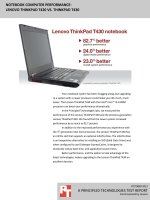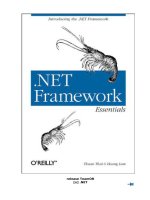IPython notebook essentials
Bạn đang xem bản rút gọn của tài liệu. Xem và tải ngay bản đầy đủ của tài liệu tại đây (2.22 MB, 190 trang )
www.it-ebooks.info
IPython Notebook Essentials
Compute scientific data and execute code interactively
with NumPy and SciPy
L. Felipe Martins
BIRMINGHAM - MUMBAI
www.it-ebooks.info
IPython Notebook Essentials
Copyright © 2014 Packt Publishing
All rights reserved. No part of this book may be reproduced, stored in a retrieval
system, or transmitted in any form or by any means, without the prior written
permission of the publisher, except in the case of brief quotations embedded in
critical articles or reviews.
Every effort has been made in the preparation of this book to ensure the accuracy
of the information presented. However, the information contained in this book is
sold without warranty, either express or implied. Neither the author, nor Packt
Publishing, and its dealers and distributors will be held liable for any damages
caused or alleged to be caused directly or indirectly by this book.
Packt Publishing has endeavored to provide trademark information about all of the
companies and products mentioned in this book by the appropriate use of capitals.
However, Packt Publishing cannot guarantee the accuracy of this information.
First published: November 2014
Production reference: 1141114
Published by Packt Publishing Ltd.
Livery Place
35 Livery Street
Birmingham B3 2PB, UK.
ISBN 978-1-78398-834-1
www.packtpub.com
Cover image by Duraid Fatouhi ()
www.it-ebooks.info
Credits
Author
Project Coordinator
L. Felipe Martins
Danuta Jones
Reviewers
Proofreaders
Sagar Ahire
Ting Baker
Steven D. Essinger, Ph.D.
Ameesha Green
David Selassie Opoku
Indexers
Commissioning Editor
Pramila Balan
Priya Sane
Acquisition Editor
Production Coordinator
Nikhil Karkal
Komal Ramchandani
Content Development Editor
Sumeet Sawant
Monica Ajmera Mehta
Cover Work
Komal Ramchandani
Technical Editor
Menza Mathew
Copy Editors
Roshni Banerjee
Sarang Chari
www.it-ebooks.info
About the Author
L. Felipe Martins holds a PhD in Applied Mathematics from Brown University
and has worked as a researcher and educator for more than 20 years. His research
is mainly in the field of applied probability. He has been involved in developing
code for the open source homework system WeBWorK, where he wrote a library for
the visualization of systems of differential equations. He was supported by an NSF
grant for this project. Currently, he is an associate professor in the Department of
Mathematics at Cleveland State University, Cleveland, Ohio, where he has developed
several courses in Applied Mathematics and Scientific Computing. His current duties
include coordinating all first-year Calculus sessions.
He is the author of the blog, All Things Computing ().
www.it-ebooks.info
About the Reviewers
Sagar Ahire is a Master's student in Computer Science. He primarily studies
Natural Language Processing using statistical techniques and relies heavily on
Python—specifically, the IPython ecosystem for scientific computing. You can
find his work at github.com/DJSagarAhire.
I'd like to thank the community of Python for coming together to
develop such an amazing ecosystem around the language itself. Apart
from that, I'd like to thank my parents and teachers for supporting me
and teaching me new things. Finally, I'd like to thank Packt Publishing
for approaching me to work on this book; it has been a wonderful
learning experience.
Steven D. Essinger, Ph.D. is a data scientist of Recommender Systems and is
working in the playlist team at Pandora in Oakland, California. He holds a PhD
in Electrical Engineering and focuses on the development of novel, end-to-end
computational pipelines employing machine-learning techniques. Steve has
previously worked in the field of biological sciences, developing Bioinformatics
pipelines for ecologists. He has also worked as a RF systems engineer and holds
numerous patents in wireless product design and RFID.
Steve may be reached via LinkedIn at />
www.it-ebooks.info
David Selassie Opoku is a developer and an aspiring data scientist. He is
currently a technology teaching fellow at the Meltwater Entrepreneurial School
of Technology, Ghana, where he teaches and mentors young entrepreneurs in
software development skills and best practices.
David is a graduate of Swarthmore College, Pennsylvania, with a BA in Biology,
and he is also a graduate of the New Jersey Institute of Technology with an MS
in Computer Science.
David has had the opportunity to work with the Boyce Thompson Institute for
Plant Research, the Eugene Lang Center for Civic and Social Responsibility, UNICEF
Health Section, and a tech start-up in New York City. He loves Jesus, spending time
with family and friends, and tinkering with data and systems.
David may be reached via LinkedIn at />
www.it-ebooks.info
www.PacktPub.com
Support files, eBooks, discount offers, and more
For support files and downloads related to your book, please visit www.PacktPub.com.
Did you know that Packt offers eBook versions of every book published, with PDF
and ePub files available? You can upgrade to the eBook version at www.PacktPub.
com and as a print book customer, you are entitled to a discount on the eBook copy.
Get in touch with us at for more details.
At www.PacktPub.com, you can also read a collection of free technical articles,
sign up for a range of free newsletters and receive exclusive discounts and offers
on Packt books and eBooks.
TM
Do you need instant solutions to your IT questions? PacktLib is Packt's online digital
book library. Here, you can search, access, and read Packt's entire library of books.
Why subscribe?
• Fully searchable across every book published by Packt
• Copy and paste, print, and bookmark content
• On demand and accessible via a web browser
Free access for Packt account holders
If you have an account with Packt at www.PacktPub.com, you can use this to access
PacktLib today and view 9 entirely free books. Simply use your login credentials for
immediate access.
www.it-ebooks.info
www.it-ebooks.info
"To my wife, Ieda Rodrigues, and my wonderful daughters, Laura and Diana."
www.it-ebooks.info
www.it-ebooks.info
Table of Contents
Preface1
Chapter 1: A Tour of the IPython Notebook
7
Getting started with Anaconda or Wakari
8
Installing Anaconda
8
Running the notebook
8
Creating a Wakari account
10
Creating your first notebook
11
Example – the coffee cooling problem
12
Exercises22
Summary22
Chapter 2: The Notebook Interface
Editing and navigating a notebook
Getting help and interrupting computations
The Edit mode
The Command mode
Cell types
IPython magics
Interacting with the operating system
Saving the notebook
Converting the notebook to other formats
Running shell commands
Running scripts, loading data, and saving data
Running Python scripts
Running scripts in other languages
Loading and saving data
www.it-ebooks.info
23
23
25
25
28
29
33
37
37
38
39
41
41
43
45
Table of Contents
The rich display system
47
Images and YouTube videos
47
HTML
49
Summary52
Chapter 3: Graphics with matplotlib
53
Chapter 4: Handling Data with pandas
79
The plot function
54
Adding a title, labels, and a legend
59
Text and annotations
62
Three-dimensional plots
66
Animations71
Summary77
The Series class
79
The DataFrame class
88
Computational and graphics tools
95
An example with a realistic dataset
101
Summary108
Chapter 5: Advanced Computing with SciPy, Numba,
and NumbaPro
109
Appendix A: IPython Notebook Reference Card
139
Appendix B: A Brief Review of Python
143
Overview of SciPy
109
Advanced mathematical algorithms with SciPy
111
Solving equations and finding optimal values
111
Calculus and differential equations
117
Accelerating computations with Numba and NumbaPro
128
Summary138
Starting the notebook
Keyboard shortcuts
Shortcuts in the Edit mode
Shortcuts in the Command mode
Importing modules
Getting help
Introduction
Basic types, expressions, and variables and their assignment
Sequence types
Lists
Tuples
Strings
[ ii ]
www.it-ebooks.info
139
139
139
140
141
141
143
143
147
147
150
151
Table of Contents
Dictionaries152
Control structures
152
Functions, objects, and methods
156
Functions
Objects and methods
156
158
Summary159
Appendix C: NumPy Arrays
161
Introduction161
Array creation and member access
161
Indexing and Slicing
164
Index167
[ iii ]
www.it-ebooks.info
www.it-ebooks.info
Preface
The world of computing has seen an incredible revolution in the past 30 years.
Not so long ago, high-performance computations required expensive hardware;
proprietary software costing hundreds, if not thousands, of dollars; knowledge of
computer languages such as FORTRAN, C, or C++; and familiarity with specialized
libraries. Even after obtaining the proper hardware and software, just setting up a
working environment for advanced scientific computing and data handling was a
serious challenge. Many engineers and scientists were forced to become operating
systems wizards just to be able to maintain the toolset required by their daily
computational work.
Scientists, engineers, and programmers were quick to address this issue. Hardware
costs decreased as performance went up, and there was a great push to develop
scripting languages that allowed integration of disparate libraries through multiple
platforms. It was in this environment that Python was being developed in the late
1980s, under the leadership of Guido Van Rossum. From the beginning, Python was
designed to be a cutting-edge, high-level computer language with a simple enough
structure that its basics could be quickly learned even by programmers who are
not experts.
One of Python's attractive features for rapid development was its interactive shell,
through which programmers could experiment with concepts interactively before
including them in scripts. However, the original Python shell had a limited set
of features and better interactivity was necessary. Starting from 2001, Fernando
Perez started developing IPython, an improved interactive Python shell designed
specifically for scientific computing.
www.it-ebooks.info
Preface
Since then, IPython has grown to be a full-fledged computational environment built
on top of Python. One of most exciting developments is the IPython notebook, a
web-based interface for computing with Python. In this book, the reader is guided
to a thorough understanding of the notebook's capabilities in easy steps. In the
course of learning about the notebook interface, the reader will learn the essential
features of several tools, such as NumPy for efficient array-based computations,
matplotlib for professional-grade graphics, pandas for data handling and analysis,
and SciPy for scientific computation. The presentation is made fun and lively by
the introduction of applied examples related to each of the topics. Last but not least,
we introduce advanced methods for using GPU-based parallelized computations.
We live in exciting computational times. The combination of inexpensive but
powerful hardware and advanced libraries easily available through the IPython
notebook provides unprecedented power. We expect that our readers will be as
motivated as we are to explore this brave new computational world.
What this book covers
Chapter 1, A Tour of the IPython Notebook, shows how to quickly get access to the
IPython notebook by either installing the Anaconda distribution or connecting
online through Wakari. You will be given an introductory example highlighting
some of the exciting features of the notebook interface.
Chapter 2, The Notebook Interface, is an in-depth look into the notebook, covering
navigation, interacting with the operating system, running scripts, and loading
and saving data. Last but not least, we discuss IPython's Rich Display System,
which allows the inclusion of a variety of media in the notebook.
Chapter 3, Graphics with matplotlib, shows how to create presentation-quality graphs
with the matplotlib library. After reading this chapter, you will be able to make
two- and three-dimensional plots of data and build animations in the notebook.
Chapter 4, Handling Data with pandas, shows how to use the pandas library for data
handling and analysis. The main data structures provided by the library are studied
in detail, and the chapter shows how to access, insert, and modify data. Data analysis
and graphical displays of data are also introduced in this chapter.
Chapter 5, Advanced Computing with SciPy, Numba, and NumbaPro, presents advanced
computational tools and algorithms that are accessible through SciPy. Acceleration
techniques using the libraries Numba and NumbaPro, including use of the GPU
for parallelization, are also covered.
[2]
www.it-ebooks.info
Preface
Appendix A, IPython Notebook Reference Card, discusses about how to start the Notebook,
the keyboard Shortcuts in the Edit and Command modes, how to import modules, and
how to access the various Help options.
Appendix B, A Brief Review of Python, gives readers an overview of the Python syntax
and features, covering basic types, expressions, variables and assignment, basic data
structures, functions, objects and methods.
Appendix C, NumPy Arrays, gives us an introduction about NumPy arrays, and shows
us how to create arrays and accessing the members of the array, finally about Indexing
and Slicing.
What you need for this book
To run the examples in this book, the following are required:
• Operating system:
°°
Windows 7 or above, 32- or 64-bit versions.
°°
Mac OS X 10.5 or above, 64-bit version.
°°
Linux-based operating systems, such as Ubuntu desktop 14.04
and above, 32- or 64-bit versions.
Note that 64-bit versions are recommended if available.
• Software:
°°
Anaconda Python Distribution, version 3.4 or above (available at
/>
Who this book is for
This book is for software developers, engineers, scientists, and students who need
a quick introduction to the IPython notebook for use in scientific computing, data
handling, and analysis, creation of graphical displays, and efficient computations.
It is assumed that the reader has some familiarity with programming in Python,
but the essentials of the Python syntax are covered in the appendices and all
programming concepts are explained in the text.
If you are looking for a well-paced introduction to the IPython notebook with a lot
of applications and code samples, this book is for you.
[3]
www.it-ebooks.info
Preface
Conventions
In this book, you will find a number of styles of text that distinguish between
different kinds of information. Here are some examples of these styles, and an
explanation of their meaning.
Code words in text, database table names, folder names, filenames, file extensions,
pathnames, dummy URLs, user input, and Twitter handles are shown as follows: "The
simplest way to run IPython is to issue the ipython command in a terminal window."
A block of code is set as follows:
temp_coffee = 185.
temp_cream = 40.
vol_coffee = 8.
vol_cream = 1.
initial_temp_mix_at_shop = temp_mixture(temp_coffee, vol_coffee, temp_
cream, vol_cream)
temperatures_mix_at_shop = cooling_law(initial_temp_mix_at_shop,
times)
temperatures_mix_at_shop
When we wish to draw your attention to a particular part of a code block, the
relevant lines or items are set in bold:
[default]
temp_coffee = 185.
temp_cream = 40.
vol_coffee = 8.
vol_cream = 1.
initial_temp_mix_at_shop = temp_mixture(temp_coffee, vol_coffee, temp_
cream, vol_cream)
temperatures_mix_at_shop = cooling_law(initial_temp_mix_at_shop,
times)
temperatures_mix_at_shop
Any command-line input or output is written as follows:
ipython notebook
[4]
www.it-ebooks.info
Preface
New terms and important words are shown in bold. Words that you see on the
screen, in menus or dialog boxes for example, appear in the text like this: "Simply,
click on the New Notebook button to create a new notebook."
Warnings or important notes appear in a box like this.
Tips and tricks appear like this.
Reader feedback
Feedback from our readers is always welcome. Let us know what you think about
this book—what you liked or may have disliked. Reader feedback is important for
us to develop titles that you really get the most out of.
To send us general feedback, simply send an e-mail to ,
and mention the book title via the subject of your message.
If there is a topic that you have expertise in and you are interested in either writing
or contributing to a book, see our author guide on www.packtpub.com/authors.
Customer support
Now that you are the proud owner of a Packt book, we have a number of things to
help you to get the most from your purchase.
Errata
Although we have taken every care to ensure the accuracy of our content, mistakes
do happen. If you find a mistake in one of our books—maybe a mistake in the text or
the code—we would be grateful if you would report this to us. By doing so, you can
save other readers from frustration and help us improve subsequent versions of this
book. If you find any errata, please report them by visiting ktpub.
com/submit-errata, selecting your book, clicking on the errata submission form link,
and entering the details of your errata. Once your errata are verified, your submission
will be accepted and the errata will be uploaded on our website, or added to any list of
existing errata, under the Errata section of that title. Any existing errata can be viewed
by selecting your title from />[5]
www.it-ebooks.info
Preface
Piracy
Piracy of copyright material on the Internet is an ongoing problem across all
media. At Packt, we take the protection of our copyright and licenses very seriously.
If you come across any illegal copies of our works, in any form, on the Internet,
please provide us with the location address or website name immediately so that
we can pursue a remedy.
Please contact us at with a link to the suspected
pirated material.
We appreciate your help in protecting our authors, and our ability to bring you
valuable content.
Questions
You can contact us at if you are having a problem with
any aspect of the book, and we will do our best to address it.
[6]
www.it-ebooks.info
A Tour of the IPython
Notebook
This chapter gives a brief introduction to the IPython notebook and highlights
some of its special features that make it a great tool for scientific and data-oriented
computing. IPython notebooks use a standard text format that makes it easy to
share results.
After the quick installation instructions, you will learn how to start the notebook
and be able to immediately use IPython to perform computations. This simple,
initial setup is all that is needed to take advantage of the many notebook features,
such as interactively producing high quality graphs, performing advanced technical
computations, and handling data with specialized libraries.
All examples are explained in detail in this book and available online. We do not
expect the readers to have deep knowledge of Python, but readers unfamiliar
with the Python syntax can consult Appendix B, A Brief Review of Python, for an
introduction/refresher.
In this chapter, we will cover the following topics:
• Getting started with Anaconda or Wakari
• Creating notebooks and then learning about the basics of editing and
executing statements
• An applied example highlighting the notebook features
www.it-ebooks.info
A Tour of the IPython Notebook
Getting started with Anaconda or Wakari
There are several approaches to setting up an IPython notebook environment. We
suggest you use Anaconda, a free distribution designed for large-scale data processing,
predictive analytics, and scientific computing. Alternatively, you can use Wakari,
which is a web-based installation of Anaconda. Wakari has several levels of service,
but the basic level is free and suitable for experimenting and learning.
We recommend that you set up both a Wakari account and a local
Anaconda installation. Wakari has the functionality of easy sharing and
publication. This local installation does not require an Internet connection
and may be more responsive. Thus, you get the best of both worlds!
Installing Anaconda
To install Anaconda on your computer, perform the following steps:
1. Download Anaconda for your platform from tinuum.
io/cshop/anaconda/.
2. After the file is completely downloaded, install Anaconda:
°°
Windows users can double-click on the installer and follow
the on-screen instruction
°°
Mac users can double-click the .pkg file and follow the
instructions displayed on screen
°°
Linux users can run the following command:
bash <downloaded file>
Anaconda supports several different versions of Python. This book
assumes you are using Version 2.7, which is the standard version that
comes with Anaconda. The most recent version of Python, Version 3.0,
is significantly different and is just starting to gain popularity. Many
Python packages are still only fully supported in Version 2.7.
Running the notebook
You are now ready to run the notebook. First, we create a directory named
my_notebooks to hold your notebooks and open a terminal window at this
directory. Different operating systems perform different steps.
[8]
www.it-ebooks.info
Chapter 1
Microsoft Windows users need to perform the following steps:
1. Open Window Explorer.
2. Navigate to the location where your notebooks are stored.
3. Click on the New Folder button.
4. Rename the folder my_notebooks.
5. Right-click on the my_notebooks folder and select Open command
window here from the context menu.
Mac OS X and other Unix-like systems' users need to perform the following steps:
1. Open a terminal window.
2. Run the following commands:
mkdir my_notebooks
cd my_notebooks
3. Then, execute the following command on the terminal window:
ipython notebook
After a while, your browser will automatically load the notebook dashboard as shown
in the following screenshot. The dashboard is a mini filesystem where you can manage
your notebooks. The notebooks listed in the dashboard correspond exactly to the files
you have in the directory where the notebook server was launched.
[9]
www.it-ebooks.info
A Tour of the IPython Notebook
Internet Explorer does not fully support all features in the IPython
notebook. It is suggested that you use Chrome, Firefox, Safari,
Opera, or another standards-conforming browser. If your default
browser is one of those, you are ready to go. Alternatively, close
the Internet Explorer notebook, open a compatible browser,
and enter the notebook address given in the command window
from which you started IPython. This will be something like
http://127.0.0.1:8888 for the first notebook you open.
Creating a Wakari account
To access Wakari, simply go to and create an account.
After logging in, you will be automatically directed to an introduction to using the
notebook interface in Wakari. This interface is shown in the following screenshot:
The interface elements as seen in the preceding screenshot are described as follows:
• The section marked 1 shows the directory listing of your notebooks and
files. On the top of this area, there is a toolbar with buttons to create new
files and directories as well as download and upload files.
• The section marked 2 shows the Welcome to Wakari notebook. This is
the initial notebook with information about IPython and Wakari. The
notebook interface is discussed in detail in Chapter 2, The Notebook Interface.
• The section marked 3 shows the Wakari toolbar. This has the New Notebook
button and drop-down menus with other tools.
[ 10 ]
www.it-ebooks.info









